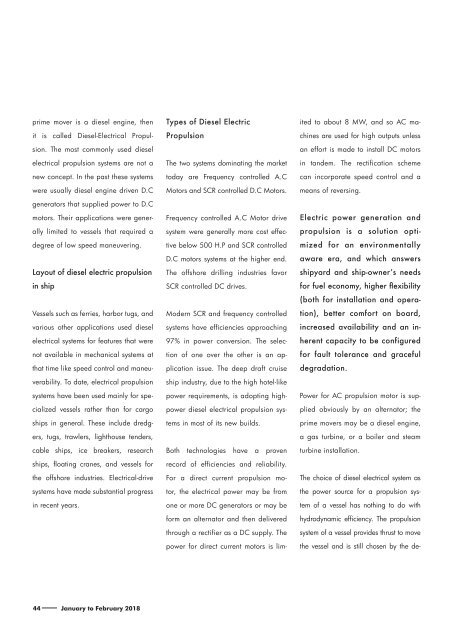Petromin marine and offshore Jan-Feb Issue
Create successful ePaper yourself
Turn your PDF publications into a flip-book with our unique Google optimized e-Paper software.
prime mover is a diesel engine, then<br />
it is called Diesel-Electrical Propulsion.<br />
The most commonly used diesel<br />
electrical propulsion systems are not a<br />
new concept. In the past these systems<br />
were usually diesel engine driven D.C<br />
generators that supplied power to D.C<br />
motors. Their applications were generally<br />
limited to vessels that required a<br />
degree of low speed maneuvering.<br />
Layout of diesel electric propulsion<br />
in ship<br />
Vessels such as ferries, harbor tugs, <strong>and</strong><br />
various other applications used diesel<br />
electrical systems for features that were<br />
not available in mechanical systems at<br />
that time like speed control <strong>and</strong> maneuverability.<br />
To date, electrical propulsion<br />
systems have been used mainly for specialized<br />
vessels rather than for cargo<br />
ships in general. These include dredgers,<br />
tugs, trawlers, lighthouse tenders,<br />
cable ships, ice breakers, research<br />
ships, floating cranes, <strong>and</strong> vessels for<br />
the <strong>offshore</strong> industries. Electrical-drive<br />
systems have made substantial progress<br />
in recent years.<br />
Types of Diesel Electric<br />
Propulsion<br />
The two systems dominating the market<br />
today are Frequency controlled A.C<br />
Motors <strong>and</strong> SCR controlled D.C Motors.<br />
Frequency controlled A.C Motor drive<br />
system were generally more cost effective<br />
below 500 H.P <strong>and</strong> SCR controlled<br />
D.C motors systems at the higher end.<br />
The <strong>offshore</strong> drilling industries favor<br />
SCR controlled DC drives.<br />
Modern SCR <strong>and</strong> frequency controlled<br />
systems have efficiencies approaching<br />
97% in power conversion. The selection<br />
of one over the other is an application<br />
issue. The deep draft cruise<br />
ship industry, due to the high hotel-like<br />
power requirements, is adopting highpower<br />
diesel electrical propulsion systems<br />
in most of its new builds.<br />
Both technologies have a proven<br />
record of efficiencies <strong>and</strong> reliability.<br />
For a direct current propulsion motor,<br />
the electrical power may be from<br />
one or more DC generators or may be<br />
form an alternator <strong>and</strong> then delivered<br />
through a rectifier as a DC supply. The<br />
power for direct current motors is limited<br />
to about 8 MW, <strong>and</strong> so AC machines<br />
are used for high outputs unless<br />
an effort is made to install DC motors<br />
in t<strong>and</strong>em. The rectification scheme<br />
can incorporate speed control <strong>and</strong> a<br />
means of reversing.<br />
Electric power generation <strong>and</strong><br />
propulsion is a solution optimized<br />
for an environmentally<br />
aware era, <strong>and</strong> which answers<br />
shipyard <strong>and</strong> ship-owner’s needs<br />
for fuel economy, higher flexibility<br />
(both for installation <strong>and</strong> operation),<br />
better comfort on board,<br />
increased availability <strong>and</strong> an inherent<br />
capacity to be configured<br />
for fault tolerance <strong>and</strong> graceful<br />
degradation.<br />
Power for AC propulsion motor is supplied<br />
obviously by an alternator; the<br />
prime movers may be a diesel engine,<br />
a gas turbine, or a boiler <strong>and</strong> steam<br />
turbine installation.<br />
The choice of diesel electrical system as<br />
the power source for a propulsion system<br />
of a vessel has nothing to do with<br />
hydrodynamic efficiency. The propulsion<br />
system of a vessel provides thrust to move<br />
the vessel <strong>and</strong> is still chosen by the de-<br />
44<br />
<strong>Jan</strong>uary to <strong>Feb</strong>ruary 2018


